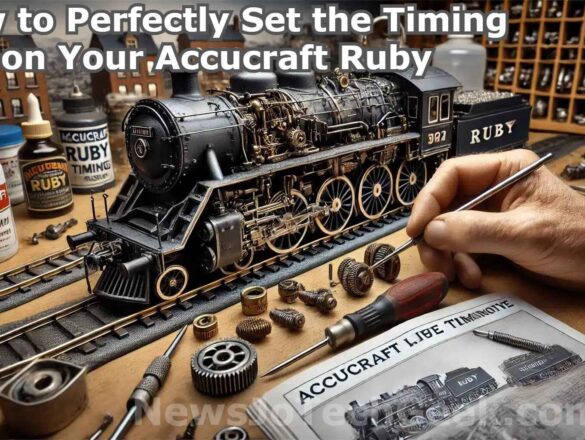Introduction
Setting the timing on your Accucraft Ruby Steam Engine is one of the most important tasks for maintaining optimal performance.
While it may seem complex at first glance, this process is manageable with the right tools and understanding.
In this detailed guide, we will walk you through the steps necessary to ensure that your Ruby steam engine runs smoothly and efficiently.
Why Setting the Timing Is Important for Your Accucraft Ruby Steam Engine

Proper timing ensures that the steam engine runs efficiently. Incorrect timing can result in poor engine performance, including reduced power, uneven operation, or mechanical damage over time.
Setting the timing correctly ensures that steam is introduced to the engine at precisely the right moments, allowing your Ruby Steam Engine to run at its best.
What You’ll Need to Set the Timing
Before diving into the timing process, it’s important to gather all the necessary tools and equipment. Here’s a list of the basics you’ll need:
- Small flathead screwdriver
- Adjustable wrench
- Timing gauge (if available, though optional)
- Safety gloves and goggles for protection
- Lubricant for maintenance
Having these tools ready will make the timing process smoother and more efficient.
Understanding the Key Components of the Ruby Steam Engine
The Accucraft Ruby Steam Engine is made up of several components that need to be properly aligned for perfect timing. The main components include:
- The Eccentric: Controls the timing of steam release to the cylinders.
- The Valve: Ensures that steam is directed to the correct side of the cylinder.
- The Piston: Converts steam pressure into mechanical motion.
Understanding the role of each component is essential to getting the timing right. Any misalignment between these parts can result in suboptimal engine performance.
Step-by-Step Guide to Set the Timing on Your Accucraft Ruby Steam Engine
Now, let’s break down the process of setting the timing into easy-to-follow steps:
Locate Top Dead Center (TDC):
First, you’ll need to position the piston at the Top Dead Center (TDC), which is the highest point in the piston stroke. This ensures the piston is in the correct starting position.
Adjust the Valve Position:
The valve must open just as the piston starts to move down. This alignment is critical for the steam to enter at the right moment.
Set the Eccentric Timing:
The eccentric is the key part that controls when steam is allowed into the cylinders. Adjust the eccentric so that it aligns with the valve and ensures the steam enters at the right moment in the piston’s stroke.
Double-Check All Alignments:
After making the initial adjustments, double-check the alignment of the valve, eccentric, and piston. Even minor misalignments can affect performance.
How to Fine-Tune the Timing for Better Performance
Once you’ve completed the basic steps, it’s time to fine-tune the timing. Here’s how:
- Check the Valve Opening: Ensure the valve opens and closes at the correct times by watching the motion of the piston.
- Adjust the Eccentric: Turn the eccentric slowly to make small adjustments to the timing. Be cautious not to over-adjust, as even a small change can make a significant difference.
Fine-tuning requires patience, but the results will be worth it when you experience smooth and powerful engine operation.
Identifying and Fixing Common Timing Problems
If you encounter issues with engine performance after setting the timing, here are some common problems and their solutions:
- Sputtering or Hesitation: This indicates the valve is either opening too early or too late. Adjust the valve slightly until the engine runs smoothly.
- Engine Running Too Slowly: This could mean the timing is too advanced. Slightly retard the timing by adjusting the eccentric.
- Lack of Power: Insufficient power often happens when the timing is delayed. Advance the timing just a little until power improves.
Taking the time to diagnose and fix these issues will ensure your engine runs like new.
How to Test the Timing and Performance
After you’ve set and fine-tuned the timing, it’s crucial to test the engine. Here’s how to perform a simple test:
- Start the Engine: Run your Ruby Steam Engine and observe its performance.
- Look for Smooth Operation: The engine should run without jerks, sputtering, or hesitation.
- Check for Power and Consistency: The engine should maintain a consistent speed and generate enough power to move.
If the engine passes these tests, you’ve successfully set the timing!
Maintaining Your Ruby Steam Engine’s Timing
Setting the timing once is not enough. Regular maintenance is essential to keep everything running smoothly:
- Inspect the Timing Regularly: Make sure the valve, eccentric, and piston remain aligned.
- Lubricate the Components: Apply lubricant to moving parts to ensure smooth operation.
- Check for Wear and Tear: Over time, parts can wear down, affecting timing. Regular checks will help prevent major issues.
Routine maintenance will extend the life of your Ruby Steam Engine and keep it running at peak performance.
How to Keep Your Ruby Steam Engine in Optimal Condition

In addition to timing, other factors contribute to the engine’s overall performance. Here are a few extra tips to keep your engine in top shape:
- Clean the Engine: Dirt and debris can interfere with the engine’s performance. Clean it regularly to ensure smooth operation.
- Monitor Steam Pressure: Ensure that the boiler pressure is within the recommended range.
- Store Properly: When not in use, store your engine in a dry, cool place to prevent rust or corrosion.
- Following these simple steps will help maintain optimal performance for years.
Safety Tips When Working with Steam Engines
Always take safety seriously when working with steam engines. Here are some essential safety precautions:
- Wear Protective Gear: Gloves and goggles are a must when handling hot components.
- Work in a Safe Area: Ensure you have plenty of space and ventilation.
- Turn Off the Engine: Always turn off the engine and allow it to cool before making adjustments.
Taking these precautions will help you avoid accidents and injuries.
Conclusion
Setting the timing on your Accucraft Ruby Steam Engine is crucial for optimal performance. By following the steps in this guide, you can ensure that your engine runs smoothly, efficiently, and with maximum power.
Regular maintenance and fine-tuning will keep your engine in great shape for years to come.
Remember, precision and patience are key to making your Ruby Steam Engine the best it can be.
FAQs
1. How often should I check and adjust the timing on my Accucraft Ruby Steam Engine?
It’s a good idea to check the timing every few months, or more often if you notice performance issues.
2. Can I set the timing without any special tools?
While tools like a timing gauge help, you can still set the timing with just a small screwdriver and adjustable wrench.
3. What should I do if my engine sputters after setting the timing?
This usually means the valve is opening too early or too late. Adjust the valve slightly and test the engine again.
4. How can I tell if the eccentric is correctly aligned?
The eccentric should release steam exactly when the valve opens, so watch the movement of the piston closely during adjustments.
5. What’s the best way to maintain my Ruby Steam Engine’s timing?
Regularly check the timing, lubricate moving parts, and clean the engine to keep everything running smoothly.




